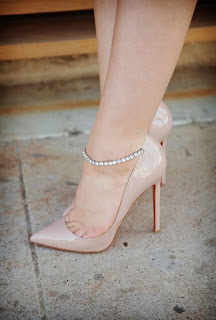Anklet - Ankle bracelet ideas for women
An anklet, also called ankle chain, ankle bracelet or ankle string, is an ornament worn around the ankle. Barefoot anklets and toe rings historically have been worn for at least over 8000 years by girls and women in South Asia, where it is commonly known as pattilu, payal and sometimes as nupur. They have also been worn by Egyptian women since predynastic times. In the United States both casual and more formal anklets became fashionable from the 1930s to the late–20th century. While in Western popular culture both younger men and women may wear casual leather anklets, they are popular among barefoot women. Formal anklets (of silver, gold, or beads) are used by some women as fashion jewellery.[citation needed] Anklets are an important piece of jewellery in Indian marriages, worn along with saris.
Occasionally, anklets on both ankles are joined by a chain to limit the step. This practice was once prevalent in Southeast Asia, where the effect was to give a "feminine" short tripping step. Today, a few Western women follow this practice, but rarely in public. More rarely still, some people wear "permanent" (e.g., soldered) ankle chains and even connecting chains.
Anklets were worn as an everyday ornament by Egyptian women of all social classes in ancient Egypt from as early as predynastic times. The name for anklets was not much different from that of bracelets being menefret (mnfrt) except by adding a phrase to denote connection to the feet. They were made of different metals and in multiple shapes, with more expensive metals like gold being more common among the rich, while less expensive ones like silver and iron more common among lower social classes. During the fourth, fifth, and sixth dynasties, anklets were usually made of beads threaded in several rows held together with spacer-bars. Anklets were also worn by dancers like those shown in the tombs of Kagemni, Ti, and Akh-hotp.
In the early–20th century, anklets were commonly worn by Egyptian women of inner cities. They were called kholkhal (pl. khalakheel) and were most commonly worn by women of Alexandria, along with a traditional dress covered by a one-piece black cloth called melaya leff.
Today, anklets are not commonly worn by Egyptian women in public due to increased Islamic conservatism that has spread in Egypt where wearing anklets in public is generally perceived as being immodest. Anklets are still commonly worn by dancers in public events.
I have a microphone on one ankle and an ankle bracelet on the other, so I'm well balanced today. Martha Stewart
Occasionally, anklets on both ankles are joined by a chain to limit the step. This practice was once prevalent in Southeast Asia, where the effect was to give a "feminine" short tripping step. Today, a few Western women follow this practice, but rarely in public. More rarely still, some people wear "permanent" (e.g., soldered) ankle chains and even connecting chains.
Anklets were worn as an everyday ornament by Egyptian women of all social classes in ancient Egypt from as early as predynastic times. The name for anklets was not much different from that of bracelets being menefret (mnfrt) except by adding a phrase to denote connection to the feet. They were made of different metals and in multiple shapes, with more expensive metals like gold being more common among the rich, while less expensive ones like silver and iron more common among lower social classes. During the fourth, fifth, and sixth dynasties, anklets were usually made of beads threaded in several rows held together with spacer-bars. Anklets were also worn by dancers like those shown in the tombs of Kagemni, Ti, and Akh-hotp.
In the early–20th century, anklets were commonly worn by Egyptian women of inner cities. They were called kholkhal (pl. khalakheel) and were most commonly worn by women of Alexandria, along with a traditional dress covered by a one-piece black cloth called melaya leff.
Today, anklets are not commonly worn by Egyptian women in public due to increased Islamic conservatism that has spread in Egypt where wearing anklets in public is generally perceived as being immodest. Anklets are still commonly worn by dancers in public events.
I have a microphone on one ankle and an ankle bracelet on the other, so I'm well balanced today. Martha Stewart






















































Comments
Post a Comment